2016 NISSAN VERSA SEDAN tires
[x] Cancel search: tiresPage 354 of 386
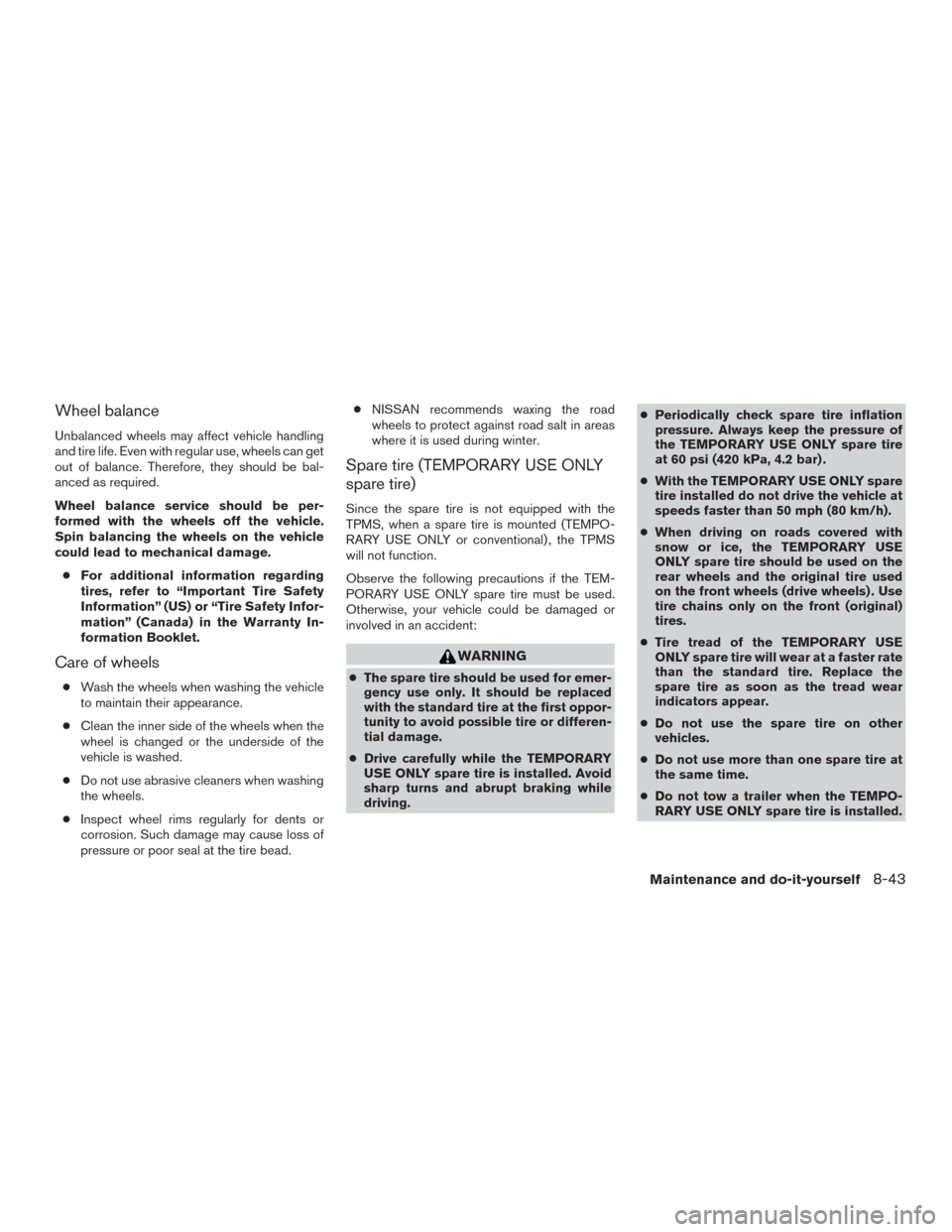
Wheel balance
Unbalanced wheels may affect vehicle handling
and tire life. Even with regular use, wheels can get
out of balance. Therefore, they should be bal-
anced as required.
Wheel balance service should be per-
formed with the wheels off the vehicle.
Spin balancing the wheels on the vehicle
could lead to mechanical damage.● For additional information regarding
tires, refer to “Important Tire Safety
Information” (US) or “Tire Safety Infor-
mation” (Canada) in the Warranty In-
formation Booklet.
Care of wheels
●Wash the wheels when washing the vehicle
to maintain their appearance.
● Clean the inner side of the wheels when the
wheel is changed or the underside of the
vehicle is washed.
● Do not use abrasive cleaners when washing
the wheels.
● Inspect wheel rims regularly for dents or
corrosion. Such damage may cause loss of
pressure or poor seal at the tire bead. ●
NISSAN recommends waxing the road
wheels to protect against road salt in areas
where it is used during winter.
Spare tire (TEMPORARY USE ONLY
spare tire)
Since the spare tire is not equipped with the
TPMS, when a spare tire is mounted (TEMPO-
RARY USE ONLY or conventional) , the TPMS
will not function.
Observe the following precautions if the TEM-
PORARY USE ONLY spare tire must be used.
Otherwise, your vehicle could be damaged or
involved in an accident:
WARNING
●The spare tire should be used for emer-
gency use only. It should be replaced
with the standard tire at the first oppor-
tunity to avoid possible tire or differen-
tial damage.
● Drive carefully while the TEMPORARY
USE ONLY spare tire is installed. Avoid
sharp turns and abrupt braking while
driving. ●
Periodically check spare tire inflation
pressure. Always keep the pressure of
the TEMPORARY USE ONLY spare tire
at 60 psi (420 kPa, 4.2 bar) .
● With the TEMPORARY USE ONLY spare
tire installed do not drive the vehicle at
speeds faster than 50 mph (80 km/h).
● When driving on roads covered with
snow or ice, the TEMPORARY USE
ONLY spare tire should be used on the
rear wheels and the original tire used
on the front wheels (drive wheels) . Use
tire chains only on the front (original)
tires.
● Tire tread of the TEMPORARY USE
ONLY spare tire will wear at a faster rate
than the standard tire. Replace the
spare tire as soon as the tread wear
indicators appear.
● Do not use the spare tire on other
vehicles.
● Do not use more than one spare tire at
the same time.
● Do not tow a trailer when the TEMPO-
RARY USE ONLY spare tire is installed.
Maintenance and do-it-yourself8-43
Page 356 of 386
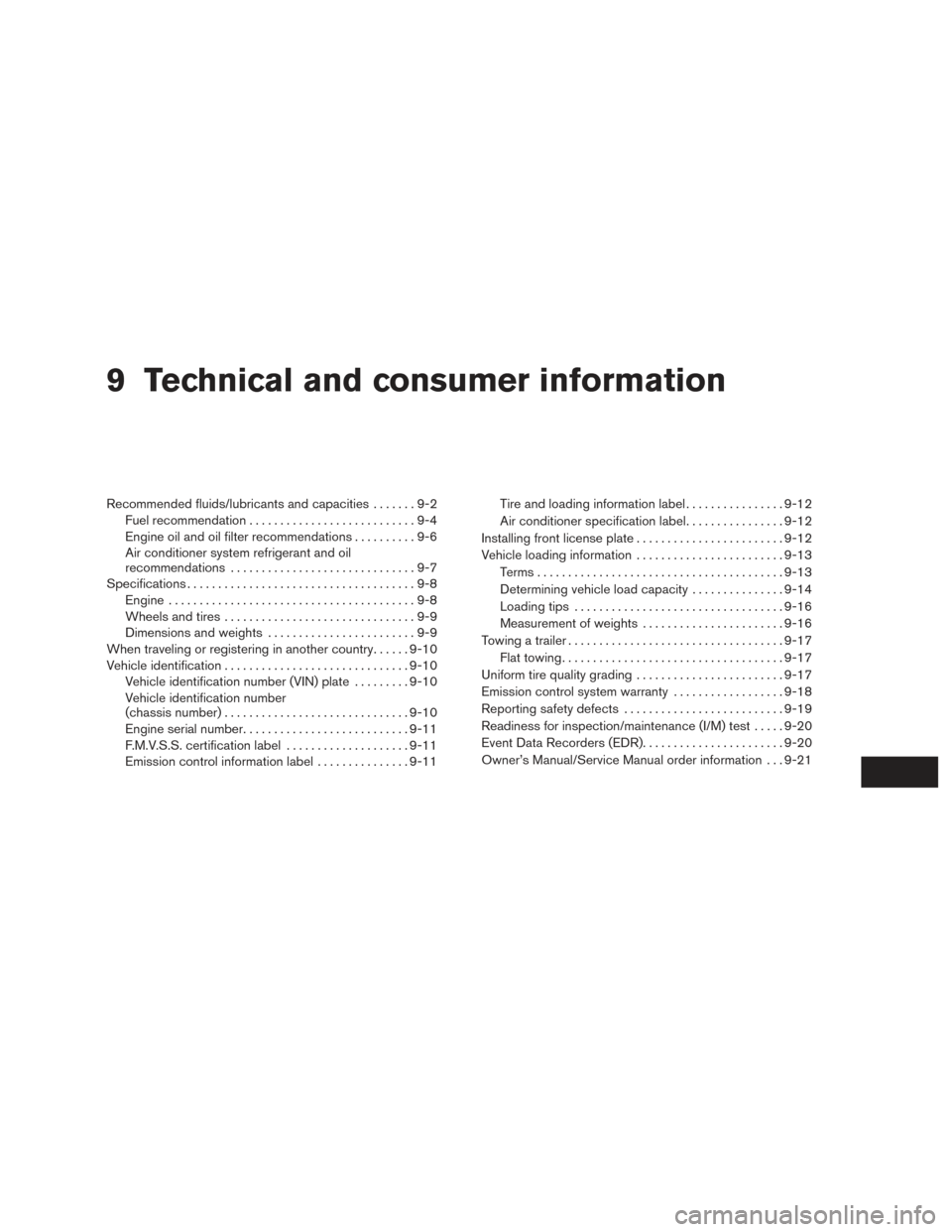
9 Technical and consumer information
Recommended fluids/lubricants and capacities.......9-2
Fuel recommendation ...........................9-4
Engine oil and oil filter recommendations ..........9-6
Air conditioner system refrigerant and oil
recommendations ..............................9-7
Specifications .....................................9-8
Engine ........................................9-8
Wheels and tires ...............................9-9
Dimensions and weights ........................9-9
When traveling or registering in another country ......9-10
Vehicle identification .............................. 9-10
Vehicle identification number (VIN) plate .........9-10
Vehicle identification number
(chassis number) .............................. 9-10
Engine serial number ........................... 9-11
F.M.V.S.S. certification label ....................9-11
Emission control information label ...............9-11Tire and loading information label
................9-12
Air conditioner specification label ................9-12
Installing front license plate ........................9-12
Vehicle loading information ........................9-13
Terms ........................................ 9-13
Determining vehicle load capacity . . .............9-14
Loading tips .................................. 9-16
Measurement of weights .......................9-16
Towing a trailer ................................... 9-17
Flat towing .................................... 9-17
Uniform tire quality grading ........................9-17
Emission control system warranty ..................9-18
Reporting safety defects .......................... 9-19
Readiness for inspection/maintenance (I/M) test .....9-20
Event Data Recorders (EDR) .......................9-20
Owner’s Manual/Service Manual order information . . . 9-21
Page 364 of 386
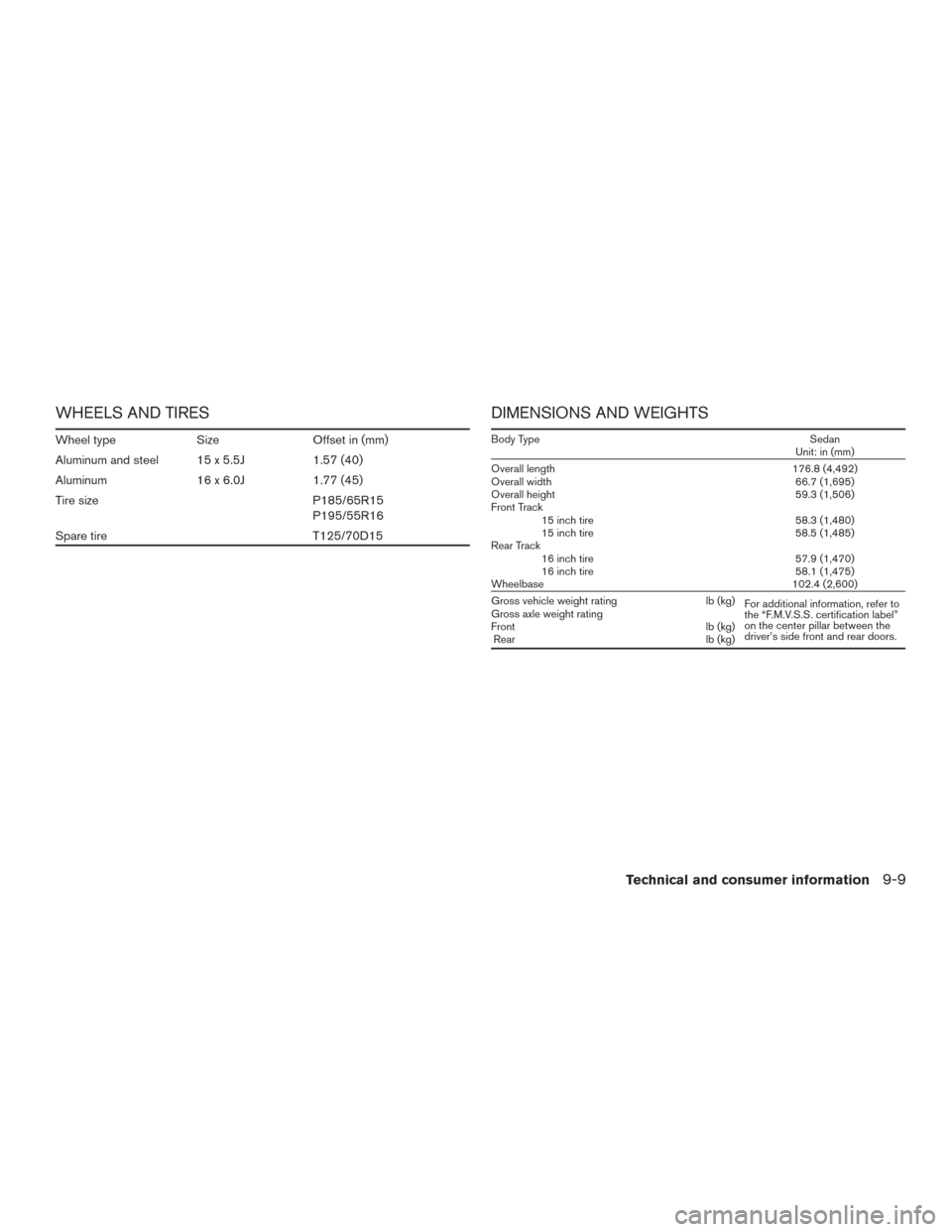
WHEELS AND TIRES
Wheel typeSizeOffset in (mm)
Aluminum and steel 15 x 5.5J 1.57 (40)
Aluminum 16 x 6.0J1.77 (45)
Tire size P185/65R15
P195/55R16
Spare tire T125/70D15
DIMENSIONS AND WEIGHTS
Body Type Sedan
Unit: in (mm)
Overall length 176.8 (4,492)
Overall width 66.7 (1,695)
Overall height 59.3 (1,506)
Front Track 15 inch tire 58.3 (1,480)
15 inch tire 58.5 (1,485)
Rear Track 16 inch tire 57.9 (1,470)
16 inch tire 58.1 (1,475)
Wheelbase 102.4 (2,600)
Gross vehicle weight rating lb (kg)
For additional information, refer to
the “F.M.V.S.S. certification label”
on the center pillar between the
driver’s side front and rear doors.
Gross axle weight rating
Front
lb (kg)
Rear lb (kg)
Technical and consumer information9-9
Page 371 of 386

5. Determine the combined weight ofluggage and cargo being loaded on
the vehicle. That weight may not
safely exceed the available cargo and
luggage load capacity calculated in
Step 4.
Before driving a loaded vehicle, confirm
that you do not exceed the Gross Vehicle
Weight Rating (GVWR) or the Gross Axle
Weight Rating (GAWR) for your vehicle.
For additional information, refer to “Mea-
surement of weights” in this section.
Also check tires for proper inflation pres-
sures. For additional information, refer to
the Tire and Loading Information label.
LOADING TIPS
● The GVW must not exceed GVWR
or GAWR as specified on the F.M-
.V.S.S. certification label.
● Do not load the front and rear axle to
the GAWR. Doing so will exceed the
GVWR.
WARNING
● Properly secure all cargo with
ropes or straps to help prevent it
from sliding or shifting. Do not
place cargo higher than the seat-
backs. In a sudden stop or colli-
sion, unsecured cargo could
cause personal injury.
● Do not load your vehicle any
heavier than the GVWR or the
maximum front and rear GAWRs.
If you do, parts of your vehicle can
break, tire damage could occur,
or it can change the way your
vehicle handles. This could result
in loss of control and cause per-
sonal injury. ●
Overloading and improper load-
ing not only can shorten the life
of your vehicle and the tire, but
can also cause unsafe vehicle
handling and longer braking dis-
tances. This may cause a prema-
ture tire failure which could result
in a serious accident and per-
sonal injury. Failures caused by
overloading are not covered by
the vehicle’s warranty.
MEASUREMENT OF WEIGHTS
Secure loose items to prevent weight
shifts that could affect the balance of your
vehicle. When the vehicle is loaded, drive
to a scale and weigh the front and the rear
wheels separately to determine axle
loads. Individual axle loads should not ex-
ceed either of the gross axle weight rat-
ings (GAWR) . The total of the axle loads
should not exceed the gross vehicle
weight rating (GVWR) . These ratings are
given on the vehicle certification label. If
weight ratings are exceeded, move or re-
move items to bring all weights below the
ratings.
9-16
Technical and consumer information
Page 372 of 386
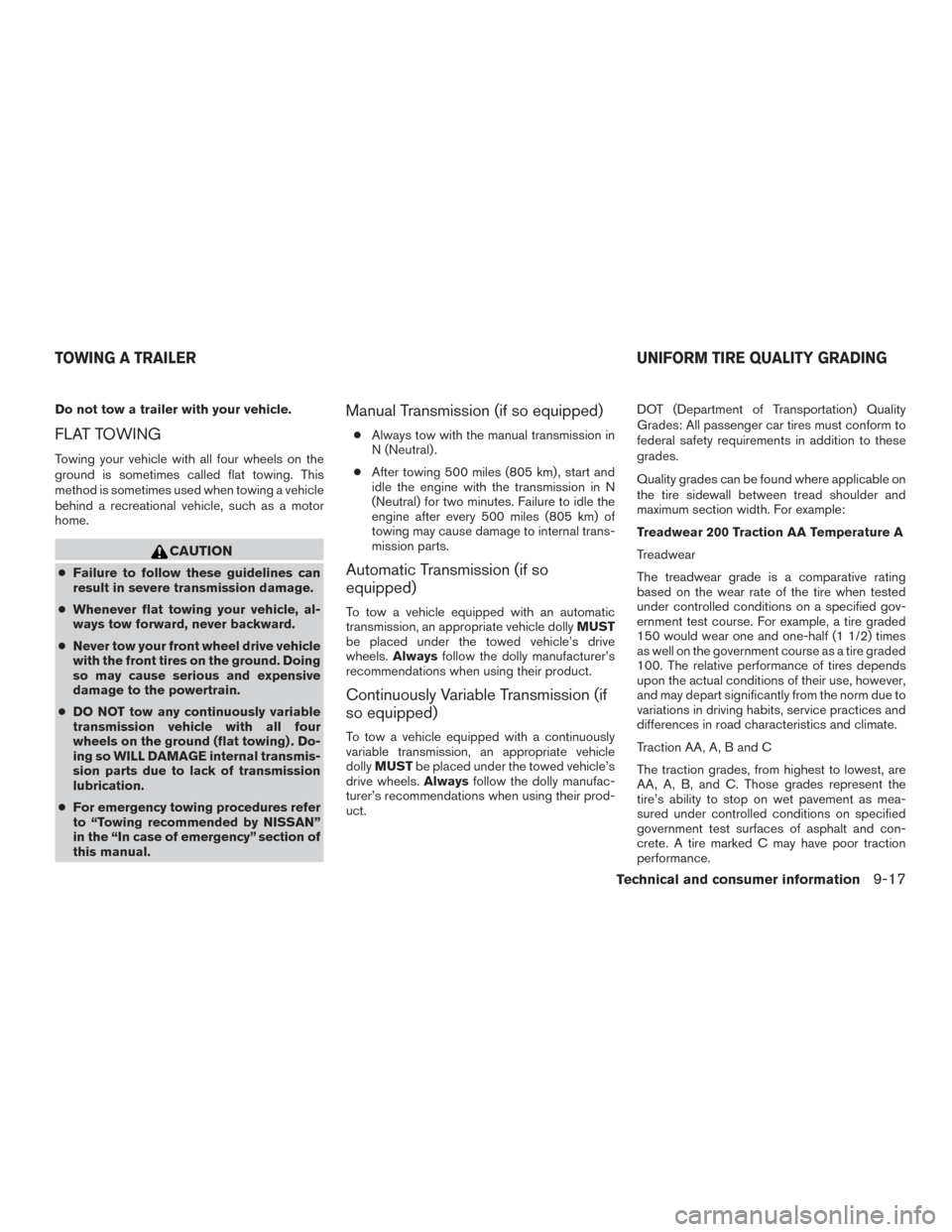
Do not tow a trailer with your vehicle.
FLAT TOWING
Towing your vehicle with all four wheels on the
ground is sometimes called flat towing. This
method is sometimes used when towing a vehicle
behind a recreational vehicle, such as a motor
home.
CAUTION
●Failure to follow these guidelines can
result in severe transmission damage.
● Whenever flat towing your vehicle, al-
ways tow forward, never backward.
● Never tow your front wheel drive vehicle
with the front tires on the ground. Doing
so may cause serious and expensive
damage to the powertrain.
● DO NOT tow any continuously variable
transmission vehicle with all four
wheels on the ground (flat towing) . Do-
ing so WILL DAMAGE internal transmis-
sion parts due to lack of transmission
lubrication.
● For emergency towing procedures refer
to “Towing recommended by NISSAN”
in the “In case of emergency” section of
this manual.
Manual Transmission (if so equipped)
● Always tow with the manual transmission in
N (Neutral) .
● After towing 500 miles (805 km) , start and
idle the engine with the transmission in N
(Neutral) for two minutes. Failure to idle the
engine after every 500 miles (805 km) of
towing may cause damage to internal trans-
mission parts.
Automatic Transmission (if so
equipped)
To tow a vehicle equipped with an automatic
transmission, an appropriate vehicle dolly MUST
be placed under the towed vehicle’s drive
wheels. Always follow the dolly manufacturer’s
recommendations when using their product.
Continuously Variable Transmission (if
so equipped)
To tow a vehicle equipped with a continuously
variable transmission, an appropriate vehicle
dolly MUST be placed under the towed vehicle’s
drive wheels. Alwaysfollow the dolly manufac-
turer’s recommendations when using their prod-
uct. DOT (Department of Transportation) Quality
Grades: All passenger car tires must conform to
federal safety requirements in addition to these
grades.
Quality grades can be found where applicable on
the tire sidewall between tread shoulder and
maximum section width. For example:
Treadwear 200 Traction AA Temperature A
Treadwear
The treadwear grade is a comparative rating
based on the wear rate of the tire when tested
under controlled conditions on a specified gov-
ernment test course. For example, a tire graded
150 would wear one and one-half (1 1/2) times
as well on the government course as a tire graded
100. The relative performance of tires depends
upon the actual conditions of their use, however,
and may depart significantly from the norm due to
variations in driving habits, service practices and
differences in road characteristics and climate.
Traction AA, A, B and C
The traction grades, from highest to lowest, are
AA, A, B, and C. Those grades represent the
tire’s ability to stop on wet pavement as mea-
sured under controlled conditions on specified
government test surfaces of asphalt and con-
crete. A tire marked C may have poor traction
performance.
TOWING A TRAILER
UNIFORM TIRE QUALITY GRADING
Technical and consumer information9-17
Page 373 of 386
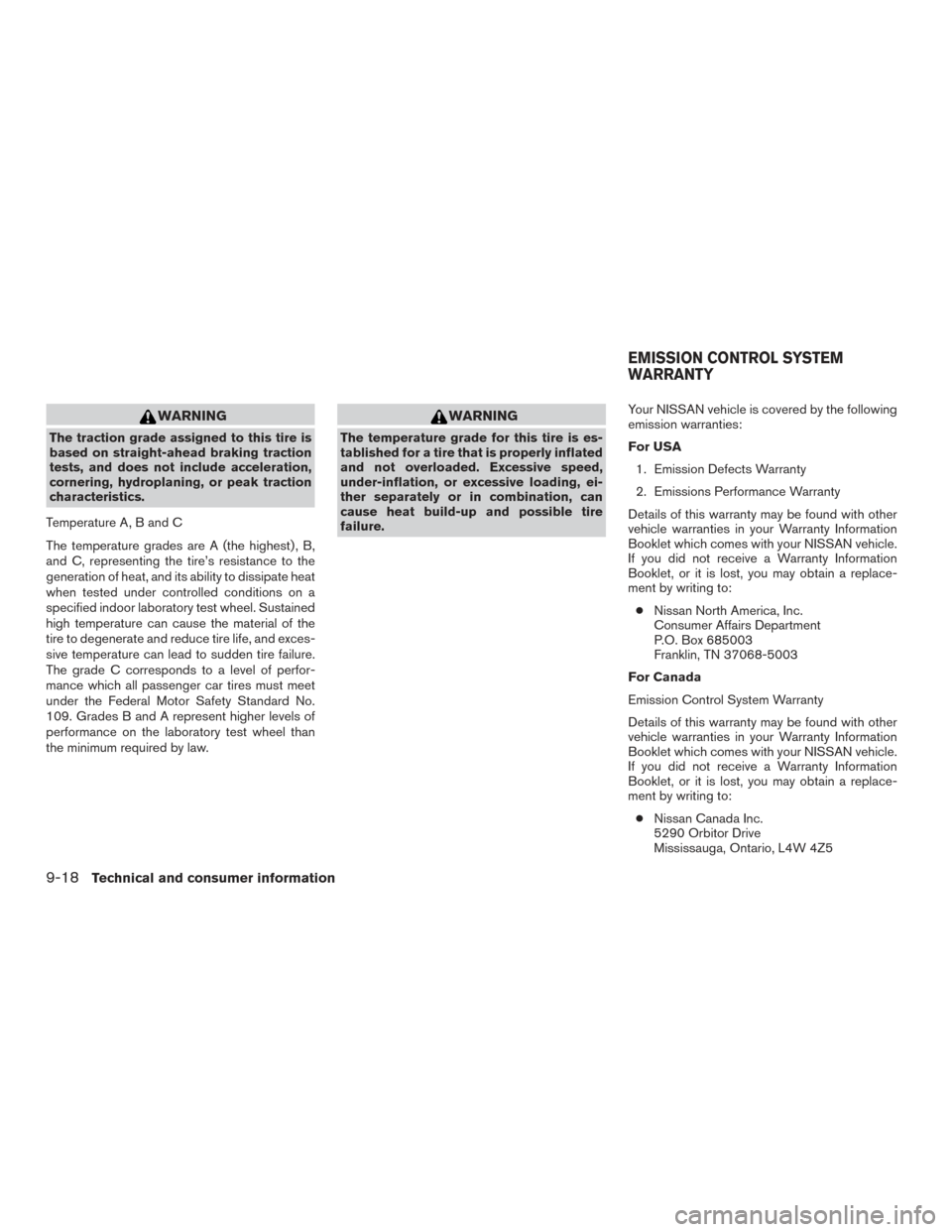
WARNING
The traction grade assigned to this tire is
based on straight-ahead braking traction
tests, and does not include acceleration,
cornering, hydroplaning, or peak traction
characteristics.
Temperature A, B and C
The temperature grades are A (the highest) , B,
and C, representing the tire’s resistance to the
generation of heat, and its ability to dissipate heat
when tested under controlled conditions on a
specified indoor laboratory test wheel. Sustained
high temperature can cause the material of the
tire to degenerate and reduce tire life, and exces-
sive temperature can lead to sudden tire failure.
The grade C corresponds to a level of perfor-
mance which all passenger car tires must meet
under the Federal Motor Safety Standard No.
109. Grades B and A represent higher levels of
performance on the laboratory test wheel than
the minimum required by law.
WARNING
The temperature grade for this tire is es-
tablished for a tire that is properly inflated
and not overloaded. Excessive speed,
under-inflation, or excessive loading, ei-
ther separately or in combination, can
cause heat build-up and possible tire
failure. Your NISSAN vehicle is covered by the following
emission warranties:
For USA
1. Emission Defects Warranty
2. Emissions Performance Warranty
Details of this warranty may be found with other
vehicle warranties in your Warranty Information
Booklet which comes with your NISSAN vehicle.
If you did not receive a Warranty Information
Booklet, or it is lost, you may obtain a replace-
ment by writing to: ● Nissan North America, Inc.
Consumer Affairs Department
P.O. Box 685003
Franklin, TN 37068-5003
For Canada
Emission Control System Warranty
Details of this warranty may be found with other
vehicle warranties in your Warranty Information
Booklet which comes with your NISSAN vehicle.
If you did not receive a Warranty Information
Booklet, or it is lost, you may obtain a replace-
ment by writing to: ● Nissan Canada Inc.
5290 Orbitor Drive
Mississauga, Ontario, L4W 4Z5
EMISSION CONTROL SYSTEM
WARRANTY
9-18Technical and consumer information
Page 383 of 386
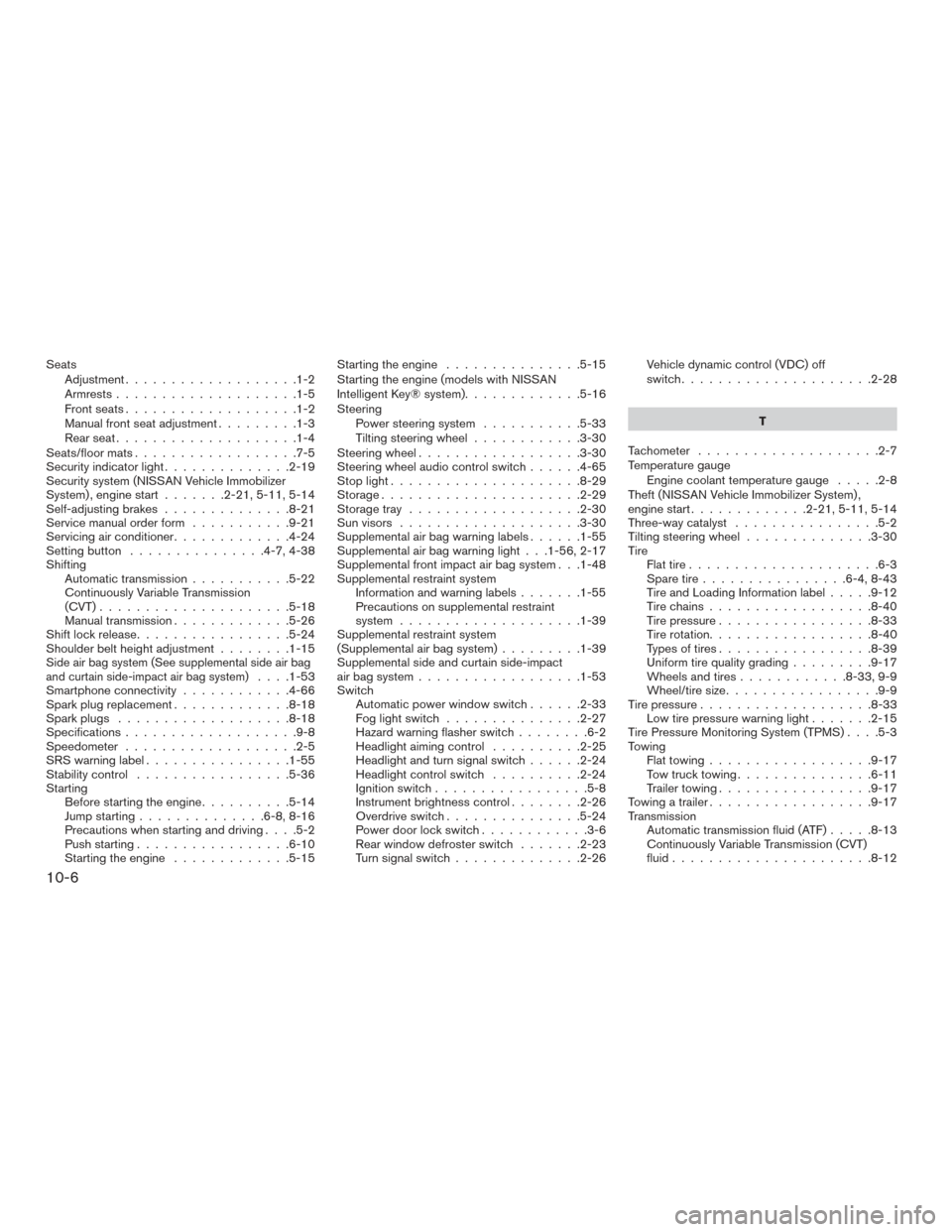
SeatsAdjustment ...................1-2
Armrests....................1-5
Frontseats...................1-2
Manual front seat adjustment .........1-3
Rear seat ....................1-4
Seats/floor mats ..................7-5
Security indicator light ..............2-19
Security system (NISSAN Vehicle Immobilizer
System) , engine start .......2-21,5-11,5-14
Self-adjusting brakes ..............8-21
Service manual order form ...........9-21
Servicing air conditioner .............4-24
Setting button ...............4-7,4-38
Shifting Automatic transmission ...........5-22
Continuously Variable Transmission
(CVT) .....................5-18
Manual transmission .............5-26
Shift lock release .................5-24
Shoulder belt height adjustment ........1-15
Side air bag system (See supplemental side air bag
and curtain side-impact air bag system)....1-53
Smartphone connectivity ............4-66
Spark plug replacement .............8-18
Spark plugs ...................8-18
Specifications ...................9-8
Speedometer ...................2-5
SRS warning label ................1-55
Stability control .................5-36
Starting Before starting the engine ..........5-14
Jump starting ..............6-8,8-16
Precautions when starting and driving ....5-2
Push starting .................6-10
Starting the engine .............5-15 Starting the engine
...............5-15
Starting the engine (models with NISSAN
Intelligent Key® system) .............5-16
Steering Power steering system ...........5-33
Tilting steering wheel ............3-30
Steeringwheel..................3-30
Steering wheel audio control switch ......4-65
Stoplight.....................8-29
Storage......................2-29
Storage tray ...................2-30
Sun visors ....................3-30
Supplemental air bag warning labels ......1-55
Supplemental air bag warning light . . .1-56, 2-17
Supplemental front impact air bag system . . .1-48
Supplemental restraint system Information and warning labels .......1-55
Precautions on supplemental restraint
system ....................1-39
Supplemental restraint system
(Supplemental air bag system) .........1-39
Supplemental side and curtain side-impact
air bag system ..................1-53
Switch Automatic power window switch ......2-33
Foglightswitch ...............2-27
Hazard warning flasher switch ........6-2
Headlightaimingcontrol ..........2-25
Headlight and turn signal switch ......2-24
Headlight control switch ..........2-24
Ignition switch .................5-8
Instrument brightness control ........2-26
Overdrive switch ...............5-24
Power door lock switch ............3-6
Rear window defroster switch .......2-23
Turn signal switch ..............2-26 Vehicle dynamic control (VDC) off
switch
.....................2-28
T
Tachometer ....................2-7
Temperature gauge Engine coolant temperature gauge .....2-8
Theft (NISSAN Vehicle Immobilizer System) ,
engine start .............2-21,5-11,5-14
Three-way catalyst ................5-2
Tilting steering wheel ..............3-30
Tire Flat tire .....................6-3
Spare tire ................6-4,8-43
Tire and Loading Information label .....9-12
Tire chains ..................8-40
Tire pressure .................8-33
Tire rotation..................
8-40
Types of tires .................8-39
Uniform tire quality grading .........9-17
Wheels and tires ............8-33,9-9
Wheel/tire size .................9-9
Tirepressure...................8-33 Low tire pressure warning light .......2-15
Tire Pressure Monitoring System (TPMS) ....5-3
Towing Flattowing..................9-17
Towtrucktowing...............6-11
Trailer towing .................9-17
Towing a trailer ..................9-17
Transmission Automatic transmission fluid (ATF) .....8-13
Continuously Variable Transmission (CVT)
fluid......................8-12
10-6
Page 384 of 386
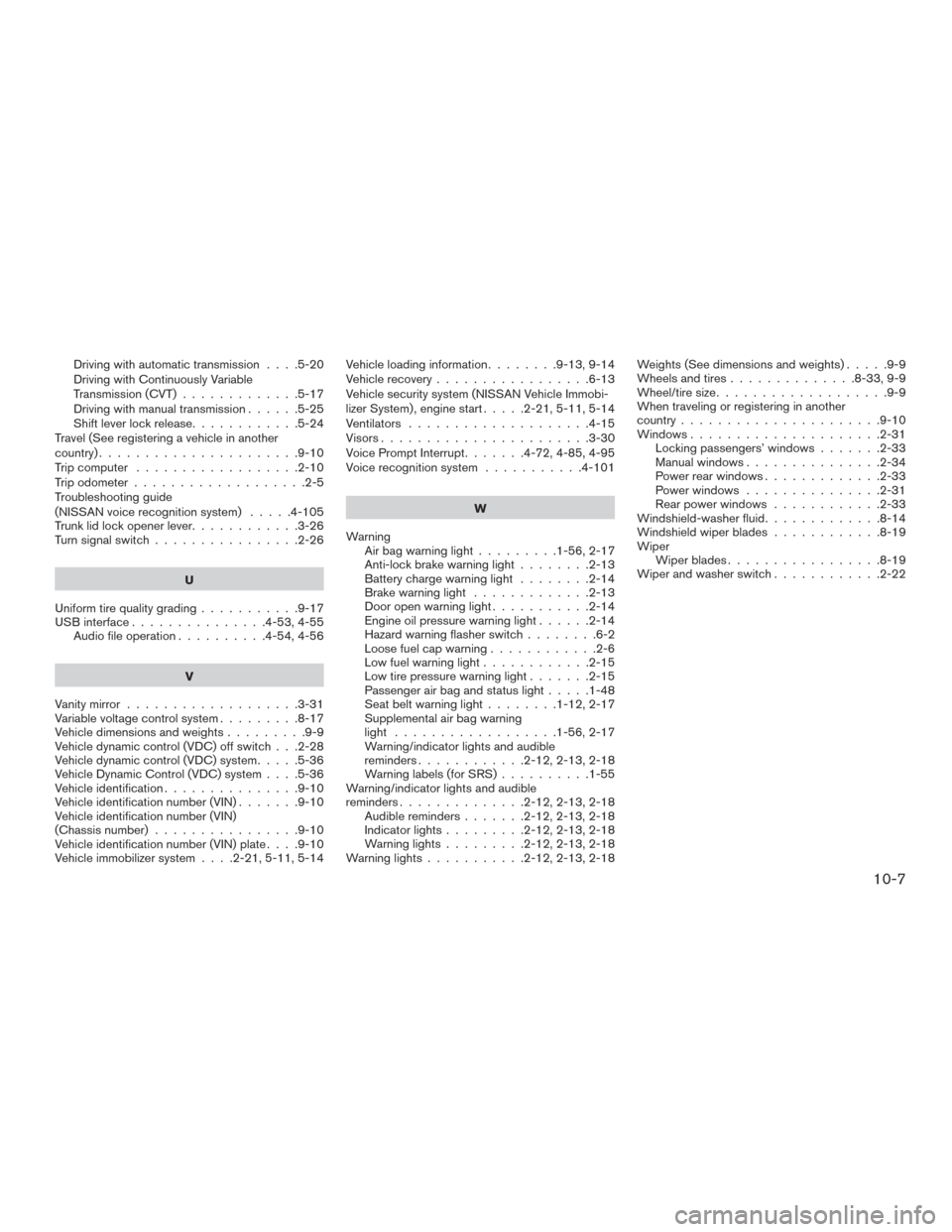
Driving with automatic transmission....5-20
Driving with Continuously Variable
Transmission (CVT) .............5-17
Driving with manual transmission ......5-25
Shiftleverlockrelease............5-24
Travel (See registering a vehicle in another
country) ......................9-10
Trip computer ..................2-10
Trip odometer ...................2-5
Troubleshooting guide
(NISSAN voice recognition system) .....4-105
Trunk lid lock opener lever ............3-26
Turn signal switch ................2-26
U
Uniform tire quality grading ...........9-17
USB interface ...............4-53,4-55
Audio file operation ..........4-54,4-56
V
Vanity mirror ...................3-31
Variable voltage control system .........8-17
Vehicledimensionsandweights.........9-9
Vehicle dynamic control (VDC) off switch . . .2-28
Vehicle dynamic control (VDC) system .....5-36
Vehicle Dynamic Control (VDC) system ....5-36
Vehicle identification ...............9-10
Vehicle identification number (VIN) .......9-10
Vehicle identification number (VIN)
(Chassis number) ................9-10
Vehicle identification number (VIN) plate ....9-10
Vehicle immobilizer system ....2-21,5-11,5-14Vehicle loading information
........9-13,9-14
Vehicle recovery .................6-13
Vehicle security system (NISSAN Vehicle Immobi-
lizer System) , engine start .....2-21,5-11,5-14
Ventilators ....................4-15
Visors.......................3-30
Voice Prompt Interrupt .......4-72,4-85,4-95
Voice recognition system ...........4-101
W
Warning Airbagwarninglight.........1-56,2-17
Anti-lock brake warning light ........2-13
Battery charge warning light ........2-14
Brake warning light .............2-13
Door open warning light ...........2-14
Engine oil pressure warning light ......2-14
Hazard warning flasher switch ........6-2
Loose fuel cap warning ............2-6
Lowfuelwarninglight............2-15
Low tire pressure warning light .......2-15
Passenger air bag and status light .....1-48
Seatbeltwarninglight........1-12,2-17
Supplemental air bag warning
light ..................1-56,2-17
Warning/indicator lights and audible
reminders............2-12,2-13,2-18
Warning labels (for SRS) ..........1-55
Warning/indicator lights and audible
reminders..............2-12,2-13,2-18 Audible reminders .......2-12,2-13,2-18
Indicatorlights.........2-12,2-13,2-18
Warninglights.........2-12,2-13,2-18
Warninglights...........2-12,2-13,2-18 Weights (See dimensions and weights)
.....9-9
Wheels and tires ..............8-33,9-9
Wheel/tire size ...................9-9
When traveling or registering in another
country ......................9-10
Windows .....................2-31
Locking passengers’ windows .......2-33
Manual windows ...............2-34
Power rear windows .............2-33
Power windows ...............
2-
31
Rear power windows ............2-33
Windshield-washerfluid.............8-14
Windshieldwiperblades............8-19
Wiper Wiperblades.................8-19
Wiper and washer switch ............2-22
10-7